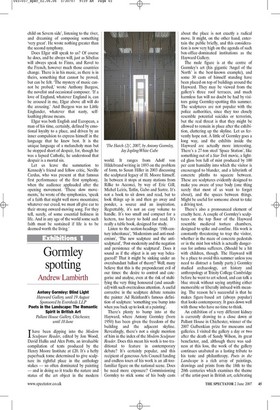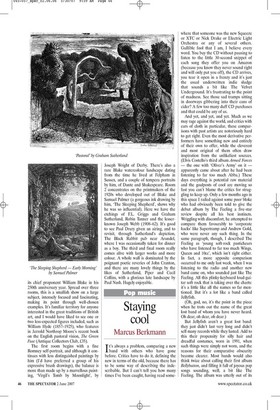Gormley spotting
Andrew Lambirth Antony Gormley: Blind Light Hayward Gallery, until 19 August Sponsored by Eversheds LLP Poets in the Landscape: The Romantic Spirit in British Art Pallant House Gallery, Chichester, until 10 June T have been dipping into the Modem 1 Sculpture Reader, edited by Jon Wood, David Hulks and Alex Potts, an invaluable compilation of texts produced by the Henry Moore Institute at £20. It's a hefty paperback tome determined to give sculpture its rightful place in the anthology stakes — so often dominated by painting — and in doing so it tracks the nature and status of the art object in the modern world. It ranges from Adolf von Hildebrand writing in 1893 on the problem of form, to Susan Hiller in 2003 discussing the sculptural legacy of H. Moore himself. In between it stops at many stations from Rilke to Acconci, by way of Eric Gill, Michel Leiris, Tatlin, Gabo and Sartre. It's not a book to sit down and read, but to look things up in and then go away and ponder, a source and an inspiration. Regrettably, it's not an easy volume to handle. It's too small and compact for a lectern, too heavy to hold and read. It's really a table book, designed for study.
Listen to the section-headings: '19th-century inheritance', 'Modernism and anti-modernism', 'The new sculpture and the antisculptural', 'Post-modernity and the negation and persistence of the sculptural'. Does it sound as if the object is in any way beleaguered? That it might be sinking under an overabundant ballast of theory? Well, many believe that this is the preponderant evil of our times: the desire to control and categorise and analyse, even at the risk of stultifying the very thing honoured (and assaulted) with such overzealous attention. A useful corrective in the sculpture debate remains the painter Ad Reinhardt's famous definition of sculpture: 'something you bump into when you back up to look at a painting'.
There's plenty to bump into at the Hayward, where Antony Gormley (born 1950) has been given the freedom of the building and the adjacent skyline. Revealingly, there's not a single mention of him in the index of the Modem Sculpture Reader. Does this mean his work is too traditional to feature in contemporary debate? It's certainly popular, and this recipient of generous Arts Council funding and endless tours of his work is an all-toofamiliar figure on the national scene. Does he need more exposure? Commissioning Gormley to stick some of his body casts about the place is not exactly a radical move. It might, on the other hand, entertain the public briefly, and this consideration is now very high on the agenda of such box-office-dominated institutions as the Hayward Gallery.
The male figure is at the centre of Gormley's art (his gigantic 'Angel of the North' is the best-known example), and some 30 casts of himself standing have been placed on top of buildings around the Hayward. They may be viewed from the gallery's three roof terraces, and much harmless fun will no doubt be had by visitors going Gormley-spotting this summer. The sculptures are not popular with the police authorities, since they too closely resemble potential suicides or terrorists, but the real threat is that they might be allowed to remain in place after the exhibition, cluttering up the skyline. Let us fervently hope not. A little of Gormley goes a long way, and the exhibits inside the Hayward are actually more interesting. There's a 27-ton steel 'Space Station', like something out of a Star Trek movie, a lighted glass box full of mist produced by 100 per cent humidity into which the visitor is encouraged to blunder, and a labyrinth of concrete plinths to squeeze between. These are sculptures evidently designed to make you aware of your body (one thing surely that most of us want to forget about), and the spaces between things. Might be useful for someone about to take a driving test.
There's also a pronounced element of cruelty here. A couple of Gormley's sculptures on the top floor of the Hayward resemble medieval torture chambers, designed to spike and confine. His work is constantly threatening to trap the visitor, whether in the maze of concrete pedestals or in the mist box which is actually dangerous for asthma sufferers. (Should be a hit with children, though. The Hayward will be a place to avoid this summer unless you need to distract a family party.) Gormley studied archaeology, art history and anthropology at Trinity College Cambridge before he went to art school, and can talk a blue streak without saying anything either memorable or liberally imbued with meaning. The reason he's successful is that he makes figure-based art (always popular) that looks contemporary. It goes down well with those who have no time to think.
An exhibition of a very different kidney is currently drawing to a close down at Pallant House in Chichester, winner of the 2007 Gulbenkian prize for museums and galleries. I visited the gallery a day or two after the death of Sandy Wilson, its great benefactor, and, although there was sadness at this loss, the work of the gallery continues unabated as a lasting tribute to his taste and philanthropy. Poets in the Landscape is a rich array of paintings, drawings and prints from the 18th to the 20th centuries which examines the theme of the artist-poet in British art, celebrating its chief proponent William Blake in his 250th anniversary year. Spread over three rooms, this is a smallish show on a large subject, intensely focused and fascinating, making its point through well-chosen examples. It's familiar territory for anyone interested in the great traditions of British art, and I would have liked to see one or two less-expected figures included, such as William Hyde (1857-1925), who features in Jerrold Northrop Moore's recent book on the English pastoral vision, The Green Fuse (Antique Collectors Club, 05).
The first room begins with a fine Romney self-portrait, and although it continues with less distinguished paintings by him (I'd have preferred a group of his expressive brush drawings), the balance is more than made up by a marvellous painting, `Virgil's Tomb by Moonlight', by Joseph Wright of Derby. There's also a rare Blake watercolour landscape dating from the time he lived at Felpham in Sussex, and a couple of tempera portraits by him, of Dante and Shakespeare. Room 2 concentrates on the printmakers of the 1920s who developed out of Blake and Samuel Palmer (a gorgeous ink drawing by him, 'The Sleeping Shepherd', shows why he was so influential). Here we have the etchings of EL. Griggs and Graham Sutherland, Robin Tanner and the lesserknown Joseph Webb (1908-62). It's good to see Paul Drury given an airing, and to revisit, through Sutherland's depiction, The Black Rabbit pub near Arundel, where I was occasionally taken for dinner as a boy. The third and final room really comes alive with larger works and more colour. A whole wall is dominated by the poignant poetic reveries of John Craxton, and there are many lovely things by the likes of Sutherland, Piper and Cecil Collins, with a glorious late landscape by Paul Nash. Hugely enjoyable.





















































 Previous page
Previous page